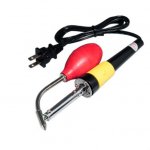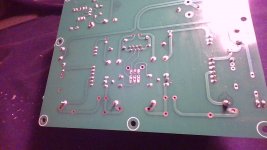I use a Goot solder sucker with the largest tip on the iron I can fit in the area and iron on full blast, makes desoldering quick. I prefer the Goot over the Metcal rework station.
Solder gets stuck in the hole because the joint is too cold and the solder is not liquid, ground planes are the hardest to desolder. A large tip a hot iron and speed means less heat soak into the PCB. A small tip and heat applied too long can have pads lifting from the PCB.
Solder gets stuck in the hole because the joint is too cold and the solder is not liquid, ground planes are the hardest to desolder. A large tip a hot iron and speed means less heat soak into the PCB. A small tip and heat applied too long can have pads lifting from the PCB.
Use the best quality solder wick is probably the best, ONLY use high quality wick as cheaper stuff sucks haha as in “doesn’t work well” you have to hold the heat for to long to get it to slowly suck up the solder and that may cause the tracks or pads to lift, some circuit board are so bad even a little heat will make the tracks lift!! there was this one board that was bullet proof I had a hot ion like 500 degrees (just to see what it would do) on it for ages just to test it and the tracks still didn’t lift but anyway.
Depending on the board and components on the board I also use centrifugal force which works good but do it outside because solder goes FLYING so resolder the pad put flux on the pad and heat it and flick it off BUT note only to be done if the pad is close to the edge as you may get bits of solder over the components which is deadly…. Circuits do not like to be shorted out!!!
also I use a compressor with a rubber tip to protect the board so add solder-flux it-heat it and blow it through, doesn’t work as good as wick but it’s good enough BUT be aware it sprays HOT solder everywhere and possibly on components on the other side of the board so do it over a bin or outside or something.
All my techniques I have learned via trial and error on old broken circuit boards from 30 years soldering every day so I have it down pat as to say well I hope haha but you never stop learning!! but if you’re a beginner I highly recommend solder wick!!
Depending on the board and components on the board I also use centrifugal force which works good but do it outside because solder goes FLYING so resolder the pad put flux on the pad and heat it and flick it off BUT note only to be done if the pad is close to the edge as you may get bits of solder over the components which is deadly…. Circuits do not like to be shorted out!!!
also I use a compressor with a rubber tip to protect the board so add solder-flux it-heat it and blow it through, doesn’t work as good as wick but it’s good enough BUT be aware it sprays HOT solder everywhere and possibly on components on the other side of the board so do it over a bin or outside or something.
All my techniques I have learned via trial and error on old broken circuit boards from 30 years soldering every day so I have it down pat as to say well I hope haha but you never stop learning!! but if you’re a beginner I highly recommend solder wick!!
Last edited:
I'm using LEO Sn-Bithmuth low temperature solder.
LEO Series | Flux cored solder | Lead-Free Solder | Products | Senju Metal Industry Co., Ltd.
Low Melt Solder
YouTube
Homemade Solder Remover Alloy - Field's Metal
YouTube
I got to know vibrator is effective a little while ago.
LEO Series | Flux cored solder | Lead-Free Solder | Products | Senju Metal Industry Co., Ltd.
Low Melt Solder
YouTube
Homemade Solder Remover Alloy - Field's Metal
YouTube
I got to know vibrator is effective a little while ago.
I haven't tried to desolder for a long long time -- since I lifted the pads and tracks off a board.
So the key to not ruining boards is... what?
So the key to not ruining boards is... what?
I haven't tried to desolder for a long long time -- since I lifted the pads and tracks off a board.
So the key to not ruining boards is... what?
Don't stress them and do NOT overheat them. If you're removing parts with no need to re-use them, cut the
leads off before de-soldering. Adding extra flux before heating is a big help. Flux pens work great for this.
I use a Metcal iron that holds the tip temperature very stable and lately have been working on Ampex boards
from 1977 replacing faulty tantalum caps. Some of the ground plane pads have no thermal relief and it
takes a couple seconds to get solder melted for a radius of 1/8 to 1/4 inch and then use a solder sucker
to remove the clipped lead and solder. Pad lifts are very rare but not unheard of.
I was working on some older Sony consumer grade video monitors that the normal 700° (F) tip was causing
some pad lifts. Changing to a 600° tip cleared that up.
I've replaced caps on computer motherboards that have internal ground planes and no thermal relief pads.
The problem with those is you can't get the heat though the lead fast enough to melt all the way through the
board. For this I use a hot air tool set to just below the solder melt point so you don't 'blow away' any surface
mount parts. I preheat the board with the hot air and then the soldering iron can melt the solder and use the
sucker to clear the hole.
Go get some junk electronics and practice. There is plenty of e-Waste stuff to practice on.
G²
In the old days I found pcb tracks/pads lifted easier.
PCB's tend to be better quality now.
Don't apply too much heat for too long.
Try to keep solder sucker vertical so it sucks through the hole and not trying to lift of the pad.
PCB's tend to be better quality now.
Don't apply too much heat for too long.
Try to keep solder sucker vertical so it sucks through the hole and not trying to lift of the pad.
Hey, thanks for these tips. Keep those cards and letter coming. I'm sure others can benefit from this advice.
I like the idea of practice. First.
Ironically, the boards are older -- circa 1977. I'm finally forced to re-work my old Leach preamp built before I knew about metal film resistors, film caps, regulated power etc.
I've also been slow to make changes for (don't laugh) sentimental reasons. The Leach was my first real project and it's been the cornerstone of my system all these years.
I probably will learn to desolder and build a new preamp.
I like the idea of practice. First.
Ironically, the boards are older -- circa 1977. I'm finally forced to re-work my old Leach preamp built before I knew about metal film resistors, film caps, regulated power etc.
I've also been slow to make changes for (don't laugh) sentimental reasons. The Leach was my first real project and it's been the cornerstone of my system all these years.
I probably will learn to desolder and build a new preamp.
This is why I like surface mount. Hit it with hot air or IR and you're done. No need to use the gun, see if you got all of it out of the hole, etc.
There are plenty of relatively cheap desoldering stations available which are much better than those lame spring loaded solder suckers.I use a Katsu desoldering station which cost £89 here in theUK.As for solder wicks,I find applying some liquid flux improves their performance.
follow-up:
I successfully removed an ALPS volume potentiometer with 6 solder legs by using SMD removal alloy ("Chip Quick", "Fast Chip).
The alloy isn't cheap, but it really helped keep the solder liquid while I gently pried the pot free.
As @apogee lover said, I apply drops of flux (rosin in ethanol) to the copper braid solder wick, and that helps mop up the excess.
Kind regards,
Drew
I successfully removed an ALPS volume potentiometer with 6 solder legs by using SMD removal alloy ("Chip Quick", "Fast Chip).
The alloy isn't cheap, but it really helped keep the solder liquid while I gently pried the pot free.
As @apogee lover said, I apply drops of flux (rosin in ethanol) to the copper braid solder wick, and that helps mop up the excess.
Kind regards,
Drew
Attachments
But wet flux works better for me, also when using rosin braid I always first dip it in liquid flux.
Sometimes you have to add solder to remove it! I use a solderpult but find that if there is not enough solder left it is harder to remove than if I add some solder to get it all to flow better. The sucker pulls the solder much better than if there is just a little. Try it!
You bet, that's often the best approach. You have to solder the joint to desolder it.
Indeed, I've had to do that "extra solder" hundreds of times over the years.
Particularly with things that were soldered with that crappy lead-free junk.
Particularly with things that were soldered with that crappy lead-free junk.
Oh especially with lead free. If I dilute the lead free with real solder it comes out so much easier.
In my mind I see it like a sponge. A dry sponge does not absorb as well as a sponge we get wet first.
In my mind I see it like a sponge. A dry sponge does not absorb as well as a sponge we get wet first.
Confirmed, I've had difficulties too, but extra solder has helped a couple of times to get the job done properly.Sometimes you have to add solder to remove it! I use a solderpult but find that if there is not enough solder left it is harder to remove than if I add some solder to get it all to flow better. The sucker pulls the solder much better than if there is just a little. Try it!
- Home
- Design & Build
- Construction Tips
- Cool trick from de-soldering.

